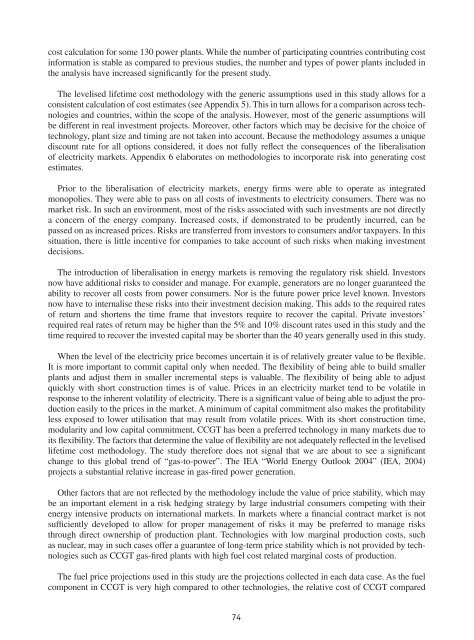Projected Costs of Generating Electricity - OECD Nuclear Energy ...
Projected Costs of Generating Electricity - OECD Nuclear Energy ...
Projected Costs of Generating Electricity - OECD Nuclear Energy ...
You also want an ePaper? Increase the reach of your titles
YUMPU automatically turns print PDFs into web optimized ePapers that Google loves.
cost calculation for some 130 power plants. While the number <strong>of</strong> participating countries contributing cost<br />
information is stable as compared to previous studies, the number and types <strong>of</strong> power plants included in<br />
the analysis have increased significantly for the present study.<br />
The levelised lifetime cost methodology with the generic assumptions used in this study allows for a<br />
consistent calculation <strong>of</strong> cost estimates (see Appendix 5). This in turn allows for a comparison across technologies<br />
and countries, within the scope <strong>of</strong> the analysis. However, most <strong>of</strong> the generic assumptions will<br />
be different in real investment projects. Moreover, other factors which may be decisive for the choice <strong>of</strong><br />
technology, plant size and timing are not taken into account. Because the methodology assumes a unique<br />
discount rate for all options considered, it does not fully reflect the consequences <strong>of</strong> the liberalisation<br />
<strong>of</strong> electricity markets. Appendix 6 elaborates on methodologies to incorporate risk into generating cost<br />
estimates.<br />
Prior to the liberalisation <strong>of</strong> electricity markets, energy firms were able to operate as integrated<br />
monopolies. They were able to pass on all costs <strong>of</strong> investments to electricity consumers. There was no<br />
market risk. In such an environment, most <strong>of</strong> the risks associated with such investments are not directly<br />
a concern <strong>of</strong> the energy company. Increased costs, if demonstrated to be prudently incurred, can be<br />
passed on as increased prices. Risks are transferred from investors to consumers and/or taxpayers. In this<br />
situation, there is little incentive for companies to take account <strong>of</strong> such risks when making investment<br />
decisions.<br />
The introduction <strong>of</strong> liberalisation in energy markets is removing the regulatory risk shield. Investors<br />
now have additional risks to consider and manage. For example, generators are no longer guaranteed the<br />
ability to recover all costs from power consumers. Nor is the future power price level known. Investors<br />
now have to internalise these risks into their investment decision making. This adds to the required rates<br />
<strong>of</strong> return and shortens the time frame that investors require to recover the capital. Private investors’<br />
required real rates <strong>of</strong> return may be higher than the 5% and 10% discount rates used in this study and the<br />
time required to recover the invested capital may be shorter than the 40 years generally used in this study.<br />
When the level <strong>of</strong> the electricity price becomes uncertain it is <strong>of</strong> relatively greater value to be flexible.<br />
It is more important to commit capital only when needed. The flexibility <strong>of</strong> being able to build smaller<br />
plants and adjust them in smaller incremental steps is valuable. The flexibility <strong>of</strong> being able to adjust<br />
quickly with short construction times is <strong>of</strong> value. Prices in an electricity market tend to be volatile in<br />
response to the inherent volatility <strong>of</strong> electricity. There is a significant value <strong>of</strong> being able to adjust the production<br />
easily to the prices in the market. A minimum <strong>of</strong> capital commitment also makes the pr<strong>of</strong>itability<br />
less exposed to lower utilisation that may result from volatile prices. With its short construction time,<br />
modularity and low capital commitment, CCGT has been a preferred technology in many markets due to<br />
its flexibility. The factors that determine the value <strong>of</strong> flexibility are not adequately reflected in the levelised<br />
lifetime cost methodology. The study therefore does not signal that we are about to see a significant<br />
change to this global trend <strong>of</strong> “gas-to-power”. The IEA “World <strong>Energy</strong> Outlook 2004” (IEA, 2004)<br />
projects a substantial relative increase in gas-fired power generation.<br />
Other factors that are not reflected by the methodology include the value <strong>of</strong> price stability, which may<br />
be an important element in a risk hedging strategy by large industrial consumers competing with their<br />
energy intensive products on international markets. In markets where a financial contract market is not<br />
sufficiently developed to allow for proper management <strong>of</strong> risks it may be preferred to manage risks<br />
through direct ownership <strong>of</strong> production plant. Technologies with low marginal production costs, such<br />
as nuclear, may in such cases <strong>of</strong>fer a guarantee <strong>of</strong> long-term price stability which is not provided by technologies<br />
such as CCGT gas-fired plants with high fuel cost related marginal costs <strong>of</strong> production.<br />
The fuel price projections used in this study are the projections collected in each data case. As the fuel<br />
component in CCGT is very high compared to other technologies, the relative cost <strong>of</strong> CCGT compared<br />
74

















